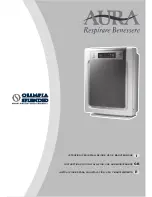
Operation manual
6
RX(Y)Q5~1 RXYQ8~18 RXYSQ4~6P7V3B
VRVIII and VRVIII-S system air conditioner
4PW28160-1A
Symptom 3: Fan operation is possible, but cooling and heating do not
work.
■
Immediately after the power is turned on.
The micro computer is getting ready to operate. Wait 10
minutes.
Symptom 4: The fan strength does not correspond to the setting.
■
The fan strength does no change even if the fan strength
adjustment button in pressed.
During heating operation, when the room temperature reaches
the set temperature, the outdoor unit goes off and the indoor unit
changes to whisper fan strength.
This is to prevent cold air blowing directly on occupants of the
room.
The fan strength will not change even if the button is changed,
when another indoor unit is in heating operation.
Symptom 5: The fan direction does not correspond to the setting
■
The fan direction does not correspond to the remote control
display. The fan direction does not swing.
This is because the unit is being controlled by the micro
computer.
Symptom 6: White mist comes out of a unit
Symptom 6.1: Indoor unit
■
When humidity is high during cooling operation
If the interior of an indoor unit is extremely contaminated, the
temperature distribution inside a room becomes uneven. It is
necessary to clean the interior of the indoor unit. Ask your dealer
for details on cleaning the unit. This operation requires a
qualified service person.
■
Immediately after the cooling operation stops and if the room
temperature and humidity are low.
This is because warm refrigerant gas flows back into the indoor
unit and generates steam.
Symptom 6.2: Indoor unit, outdoor unit
■
When the system is changed over to heating operation after
defrost operation
Moisture generated by defrost becomes steam and is
exhausted.
Symptom 7: The remote controller display reads "U4" or "U5" and stops,
but then restarts after a few minutes
■
This is because the remote control is intercepting noise from
electric appliances other than the air conditioner. This prevents
communication between the units, causing them to stop.
Operation automatically restarts when the noise ceases.
Symptom 8: Noise of air conditioners
Symptom 8.1: Indoor unit
■
A "zeen" sound is heard immediately after the power supply is
turned on.
The electronic expansion valve inside an indoor unit starts
working and makes the noise. Its volume will reduce in about
one minute.
■
A continuous low "shah" sound is heard when the system is in
cooling operation or at a stop
When the drain pump (optional accessories) is in operation, this
noise is heard.
■
A "pishi-pishi" squeaking sound is heard when the system stops
after heating operation.
Expansion and contraction of plastic parts caused by
temperature change make this noise.
■
A low "sah", "choro-choro" sound is heard while the indoor unit
is stopped.
When the other indoor unit is in operation, this noise is heard. In
order to prevent oil and refrigerant from remaining in the system,
a small amount of refrigerant is kept flowing.
Symptom 8.2: Indoor unit, outdoor unit
■
A continuous low hissing sound is heard when the system is in
cooling or defrost operation.
This is the sound of refrigerant gas flowing through both indoor
and outdoor units.
■
A hissing sound which is heard at the start or immediately after
stopping operation or defrost operation.
This is the noise of refrigerant caused by flow stop or flow
change.
Symptom 8.3: Outdoor unit
■
When the tone of operating noise changes.
This noise is caused by the change of frequency.
Symptom 9: Dust comes out of the unit
■
When the unit is used for the first time in a long time.
This is because dust has gotten into the unit.
Symptom 10: The units can give off odours
■
The unit can absorb the smell of rooms, furniture, cigarettes,
etc., and then emit it again.
Symptom 11: The outdoor unit fan does not spin.
■
During operation.
The speed of the fan is controlled in order to optimize product
operation.
Symptom 12: The display shows "
"
.
■
This is the case immediately after the main power supply switch
is turned on and means that the remote controller is in normal
condition. This continues for one minute.
Symptom 13: The compressor in the outdoor unit does not stop after a
short heating operation
■
This is to prevent oil and refrigerant from remaining in the
compressor. The unit will stop after 5 to 10 minutes.
Symptom 14: The inside of an outdoor unit is warm even when the unit
has stopped
■
This is because the crankcase heater is warming the
compressor so that the compressor can start smoothly.
Symptom 15: Hot air can be felt when the indoor unit is stopped
■
Several different indoor units are being run on the same system.
When another unit is running, some refrigerant will still flow
through the unit.
10. T
ROUBLESHOOTING
If one of the following malfunctions occur, take the measures shown
below and contact your dealer.
The system must be repaired by a qualified service person.
■
If a safety device such as a fuse, a breaker or an earth leakage
breaker frequently actuates, or the ON/OFF switch does not
properly work.
Measure: Turn off the main power switch.
■
If water leaks from unit
Measure: Stop the operation.
■
The operation switch does not work well.
Measure: Turn off the power.
WARNING
Stop operation and shut off the power if anything
unusual occurs (burning smells, etc.)
Leaving the unit running under such circumstances may
cause breakage, electric shock, or fire.
Contact your dealer.
Содержание RXQ14P7W1B
Страница 11: ...NOTES NOTES ...
Страница 12: ...Zandvoordestraat 300 B 8400 Oostende Belgium 4PW28160 1A ...






























